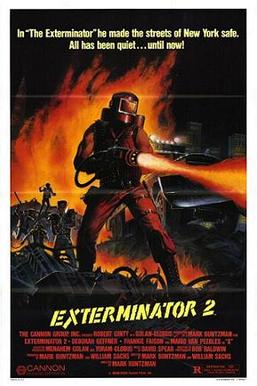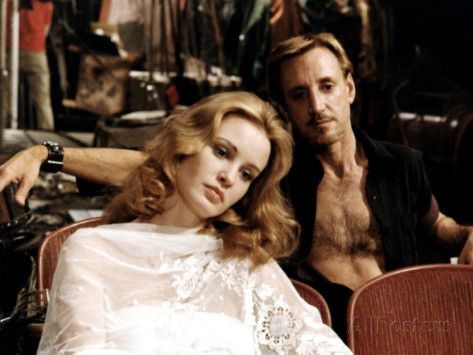Four years after the end of the first Exterminator, the man they drove too far is driven too far again….
As you may remember, the first Exterminator ended with the CIA shooting vigilante John Eastland (Robert Ginty) because Eastland’s anti-crime activities were somehow making the President look bad. The wounded Eastland fell into the Hudson River. “Washington will be pleased,” the CIA agent said to the gunman. However, the film’s final shot revealed that Eastland had survived his plunge.
1984’s Exterminator 2 opens with Eastland returning to New York City. He’s got a small apartment and a police scanner and when he hears a report that an elderly couple is being menaced by a group of thugs, he puts on a welding mask and uses his flame thrower to set the criminals on fire. Of course, he doesn’t actually arrive in time to save the old couple from getting shot and killed. Just because Eastland has decided to become a vigilante, that doesn’t mean that he’s particularly good at it.
The first Exterminator was a grim and gritty thriller that took itself very seriously. In fact, one could argue that it took itself a bit too seriously. Exterminator 2, which was produced by Cannon Films, takes a slightly different approach. This is obvious as soon as Mario Van Peebles shows up as X, a cult leader who is looking to take over the New York drug trade. Van Peebles, with his model good looks and his quick smile, is not exactly the most intimidating of villains. And X is not exactly the most brilliant of bad guys. For one thing, he drives a car with a big red X spray painted on one of the doors, which doesn’t seem to be the smartest thing to do when you have both the police and crazed vigilante hunting for you.
Fortunately, for X, John Eastland is easily distracted. After he sets a few people on fire, he seems to lose interest in actually being a vigilante and instead, a large portion of the film is taken up with him getting a job collecting garbage with his friend, Be Gee (Frankie Fasion). (Much like the previous film’s Michael Jefferson, Be Gree served with Eastland in Nam.) Eastland also meets and falls in love with a dancer named Caroline (Deborah Geffner). Unfortunately, a trip to Central Park leads to Caroline getting attacked by a bunch of X’s followers. With Caroline in a wheelchair, Eastland has little choice but to pick up his flame thrower and transform his garbage truck into a tank of destruction….
Exterminator 2‘s production was a troubled one. Director Mark Buntzman was one of the producers of the first Exterminator and apparently, Cannon disliked his first cut of Exterminator 2. Director William Sachs (who was Cannon’s resident “film doctor”) was brought in to do extensive reshoots in Los Angeles. Unfortunately, by the time Sachs was brought in, Robert Ginty had already moved on to another project and Sachs was forced to use his stunt double for any scenes involving Eastland. (This is one reason why Eastland spends much of the film wearing a welder’s mask.) Also because of Ginty’s absence, Sachs ended up adding a lot of scenes that focused on Van Peebles’s performance as X, with the end result being that the film often seems to be more about X and his gang than it is about Eastland and his hunt for revenge. (Unfortunately, this also led to a lot of unresolved subplots, including one in which X orders one of his roller skating henchman to kidnap a woman off the street so she can be used to test a new batch of heroin.) Many of the scenes featuring Ginty have a totally different feel to them from the scenes featuring Van Peebles and Ginty’s stunt double.
The end result is a film that really doesn’t have any sort of narrative momentum. One is never really sure what either X or Eastland is hoping to accomplish. Instead, they just kind of wander around until they have their final confrontation. Along the way, there’s a few poorly edited fights but there’s also a lot of scenes that are just included to serve as filler. As I already mentioned, Van Peebles is not a particularly menacing villain but Ginty also isn’t a particularly compelling hero. Ginty’s goofy screen presence was nicely subverted by the grime and grit of the first Exterminator but, in the second film, he just comes across as being petulant and even a bit whiny.
The first Exterminator famously ended with the lines, “Washington will be pleased.” I don’t think anyone would particularly be pleased with Exterminator 2. As a final note, I will admit that I was so bored with this film that, when I watched it, I barely noticed when it ended and Tubi segued into showing a film called Executioner 2. That pretty much sums up the entire Exterminator 2 experience.





